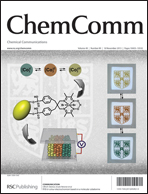Computational characterization of a mechanism for the copper-catalyzed aerobic oxidative trifluoromethylation of terminal alkynes†
Abstract
A reaction mechanism for the copper(I)-catalyzed oxidative aerobic trifluoromethylation of terminal alkynes has been determined by DFT calculations. The transmetalation of CF3− to copper appears to be a ligand replacement process independent of the metal. The dioxygen activation follows the sequence η1-superoxocopper(II), μ-η2:η2-peroxodicopper(II) and bis(μ-oxo)-dicopper(III).


 Please wait while we load your content...
Please wait while we load your content...